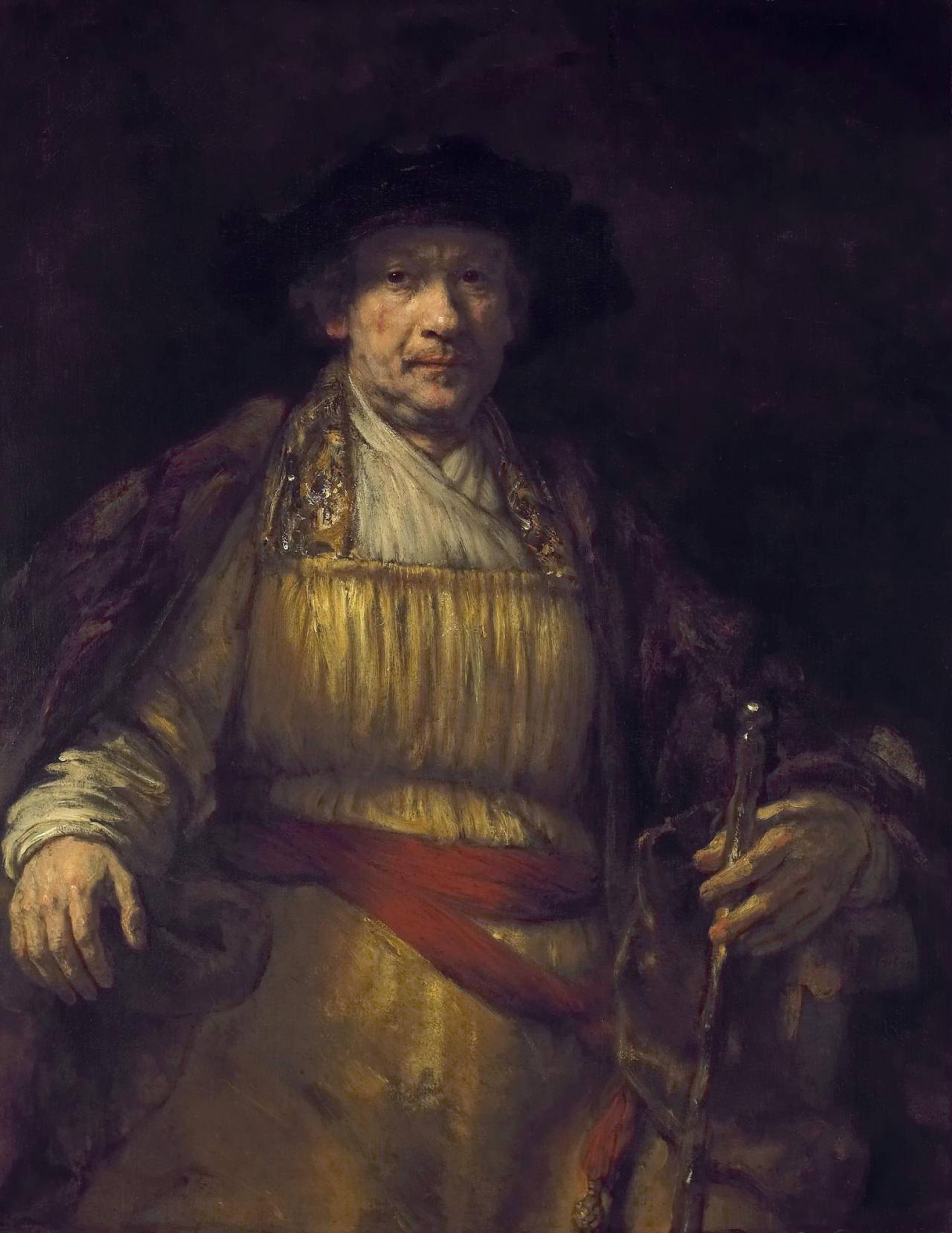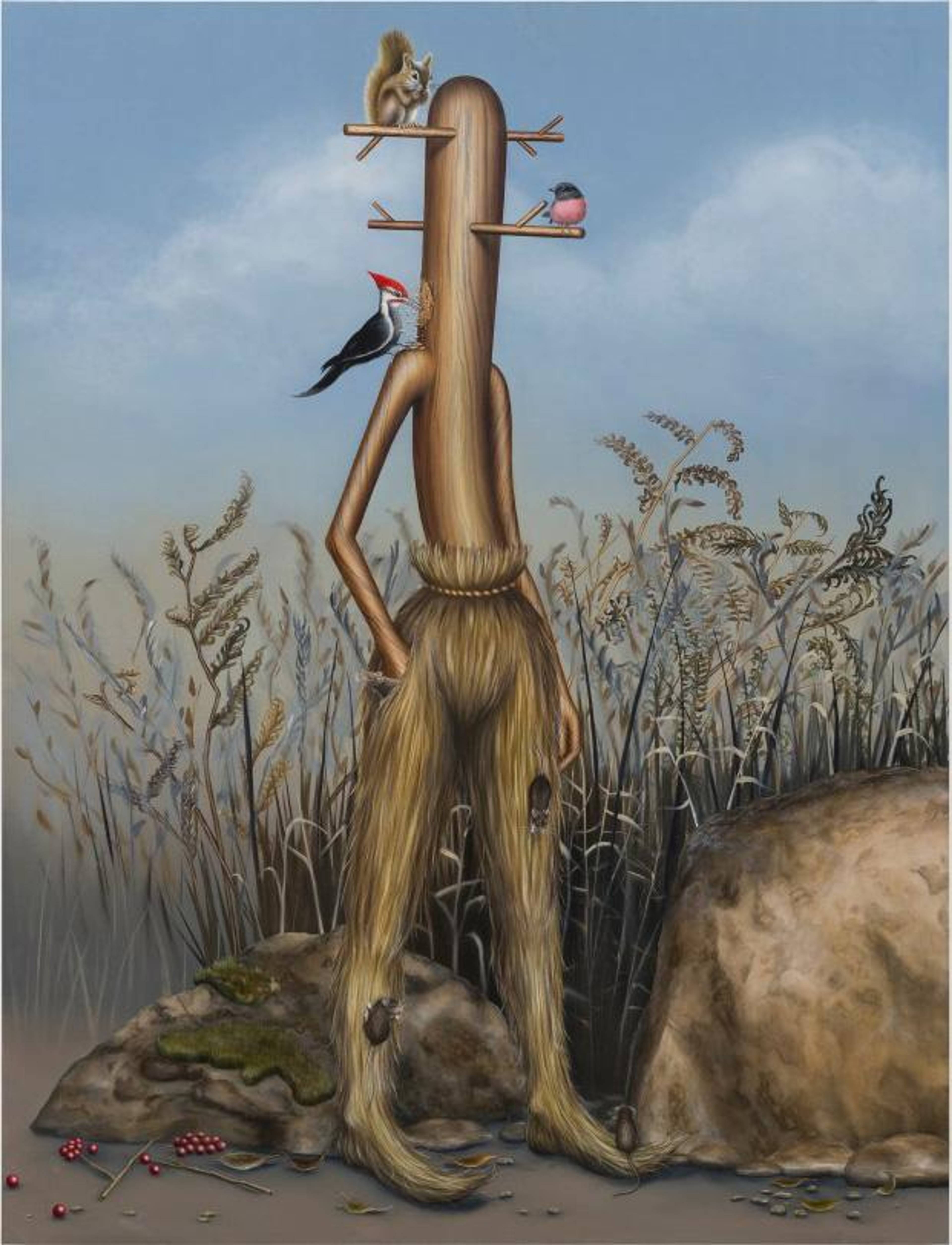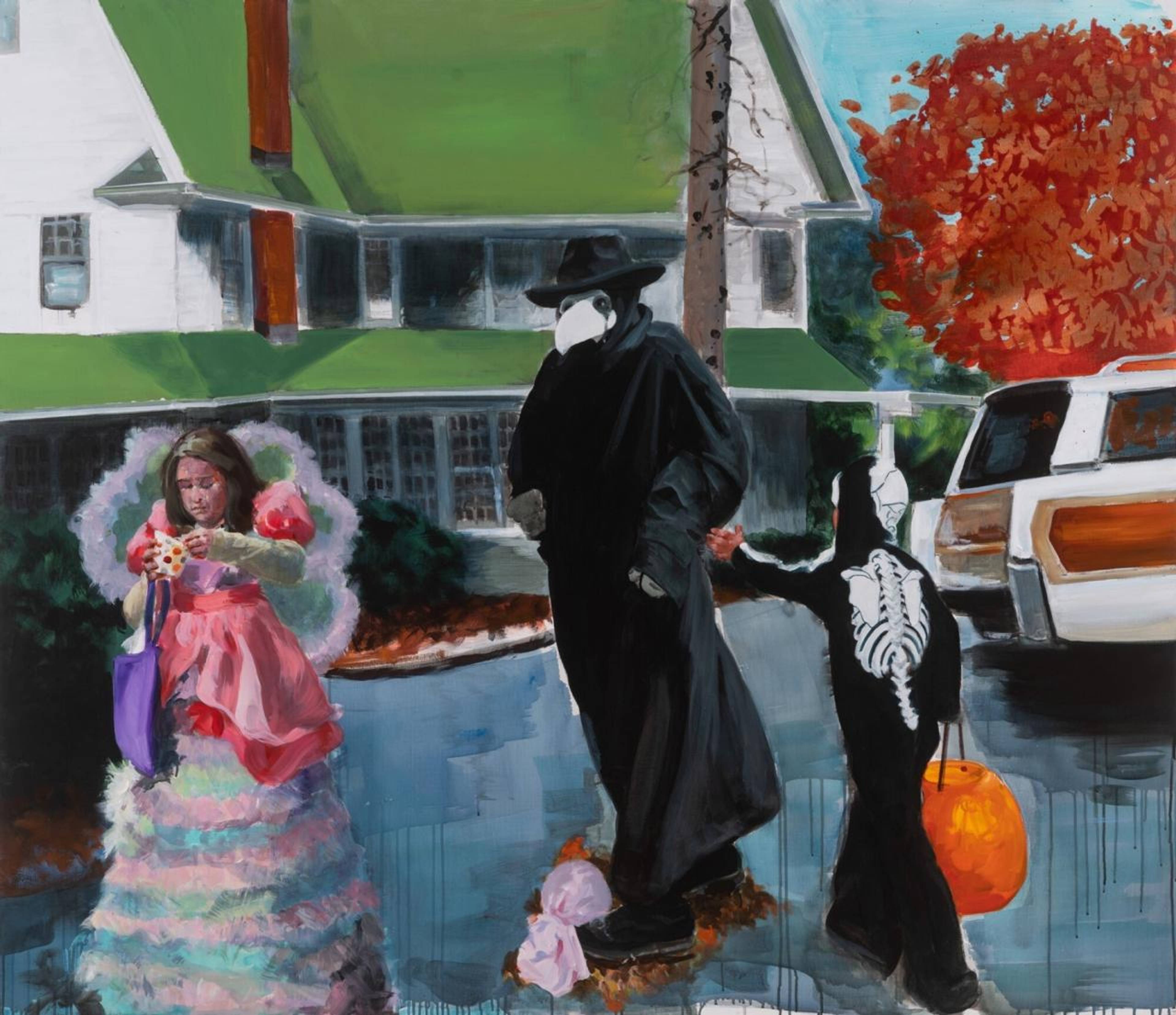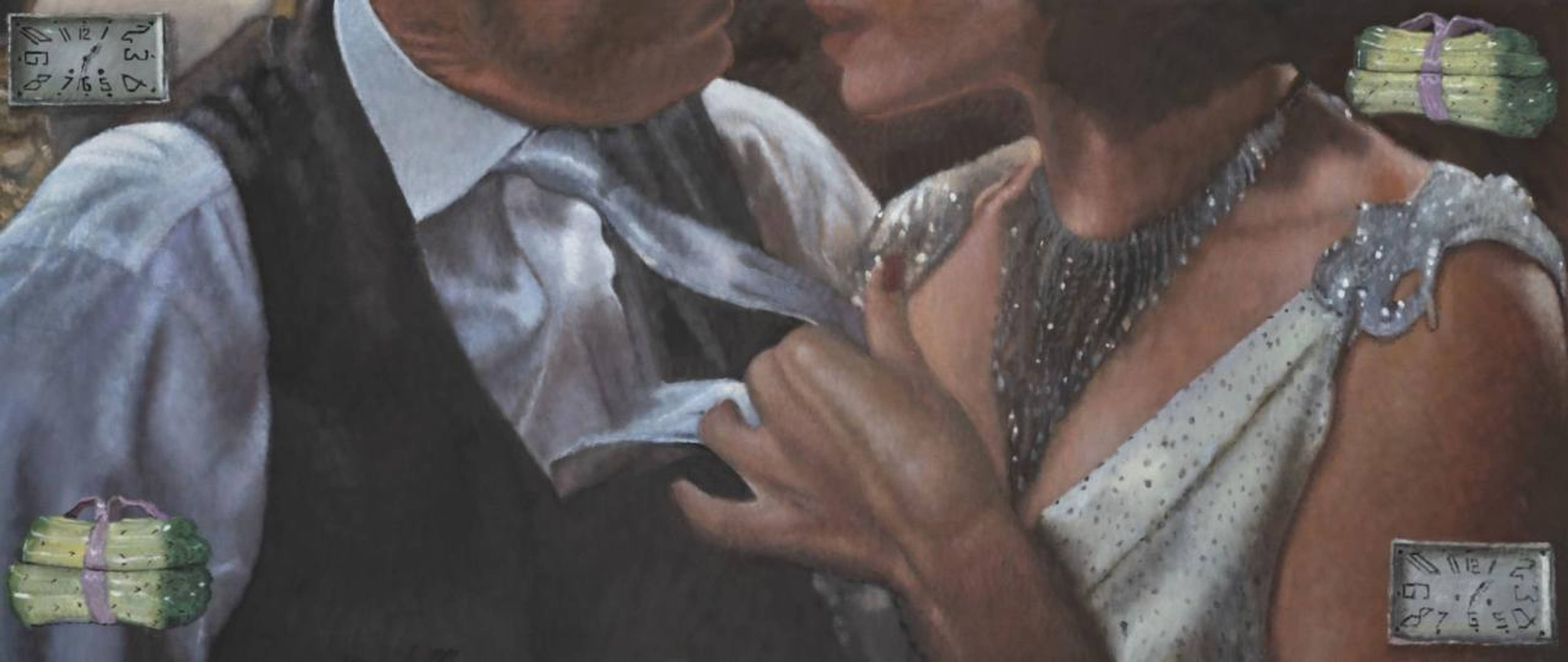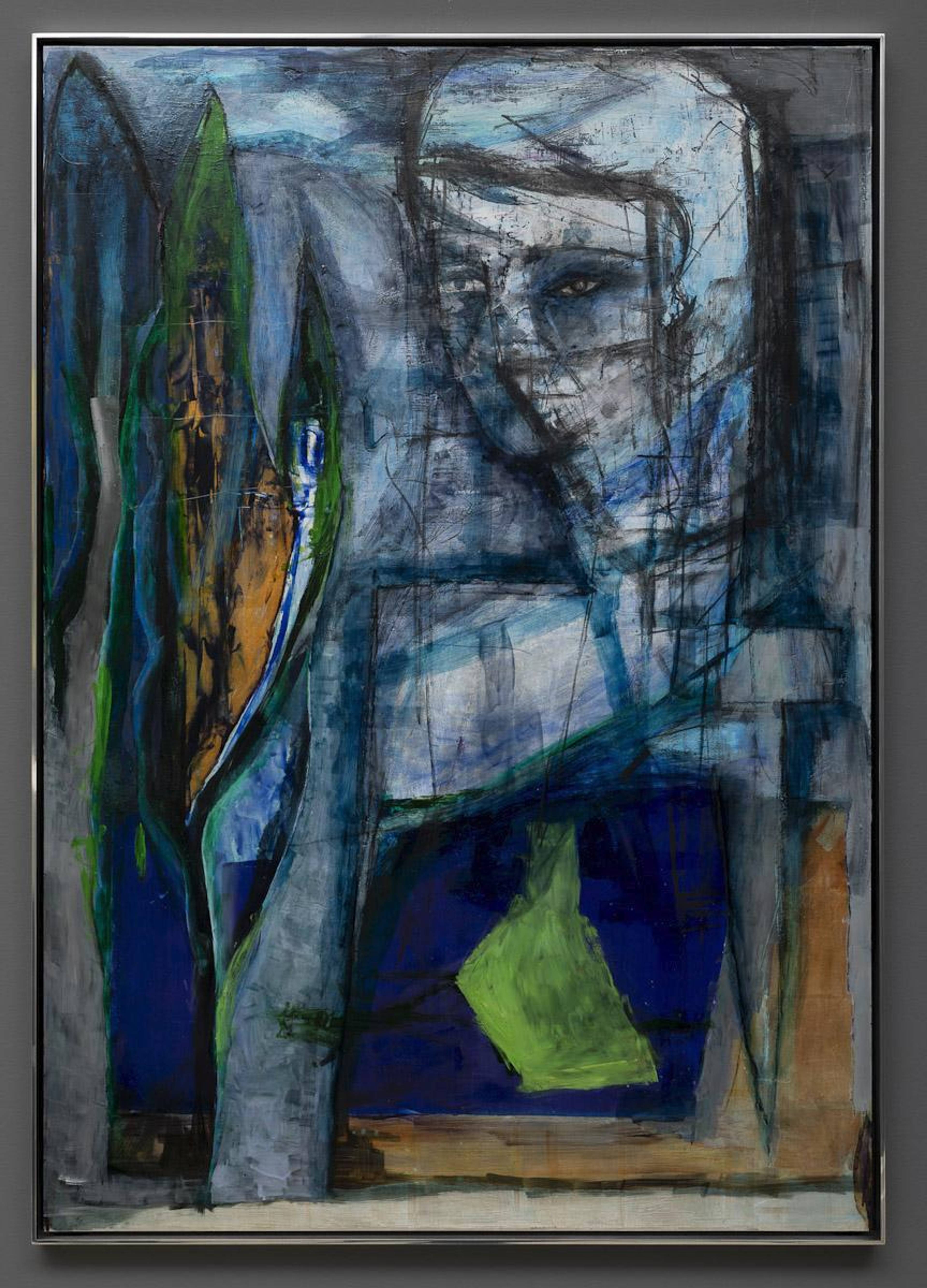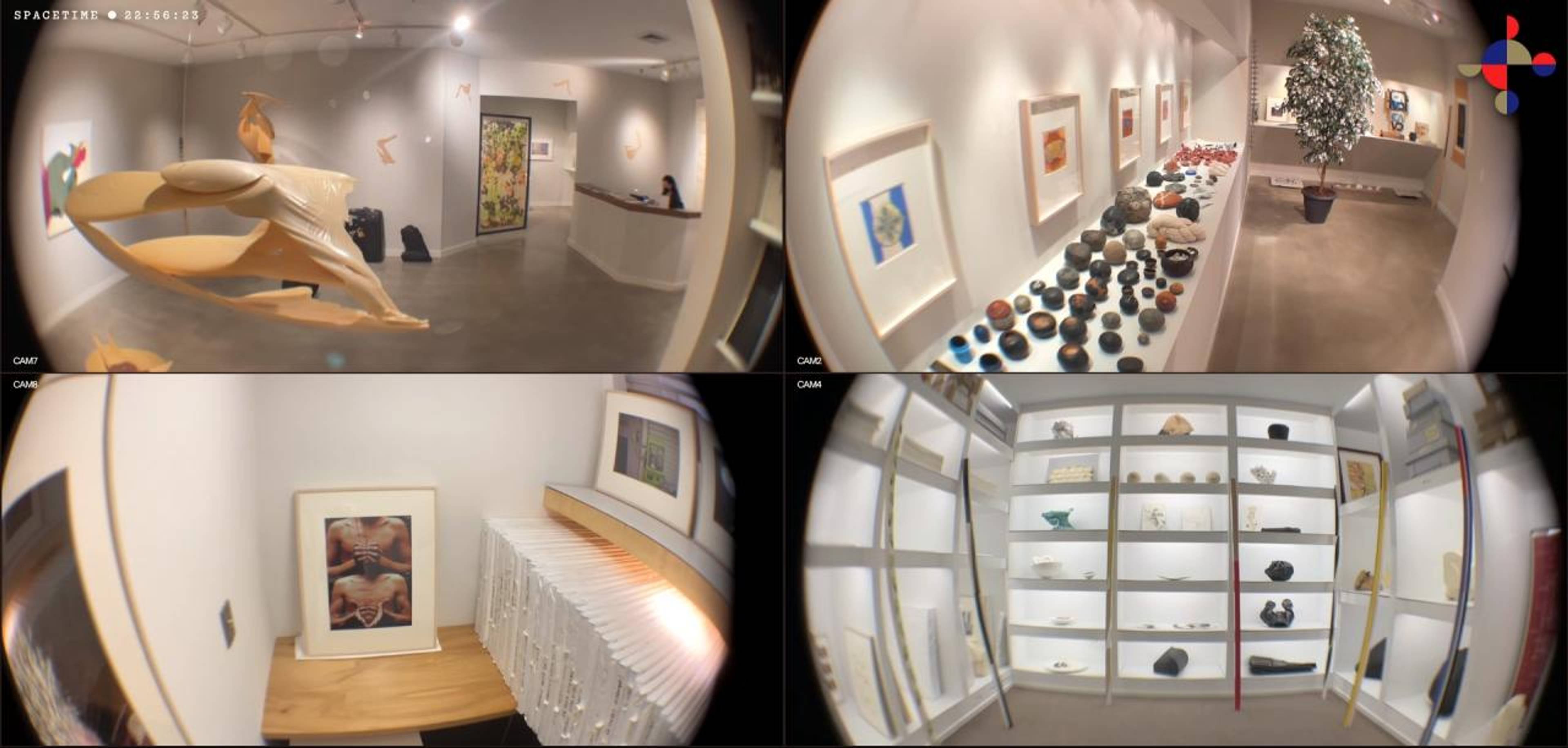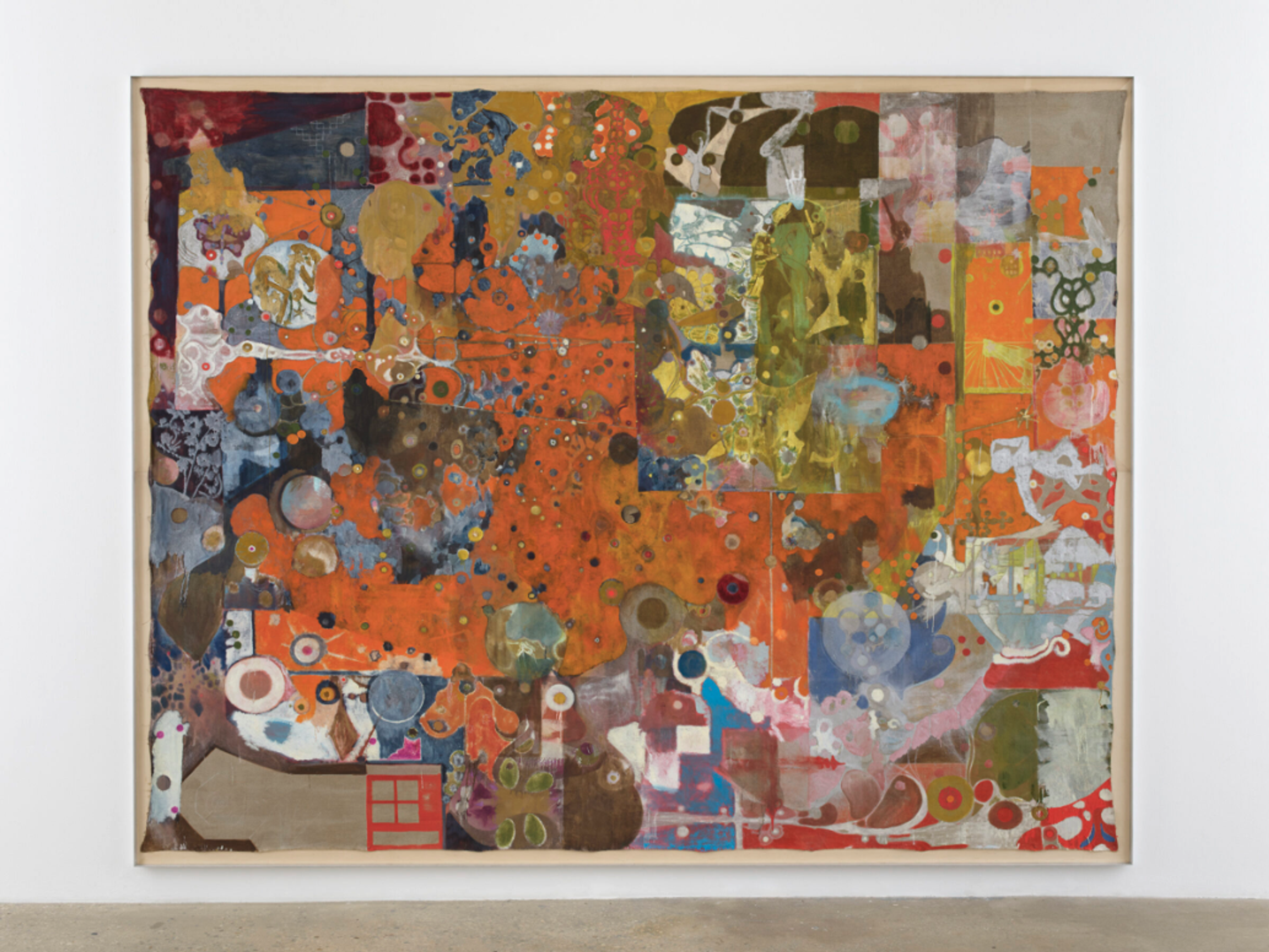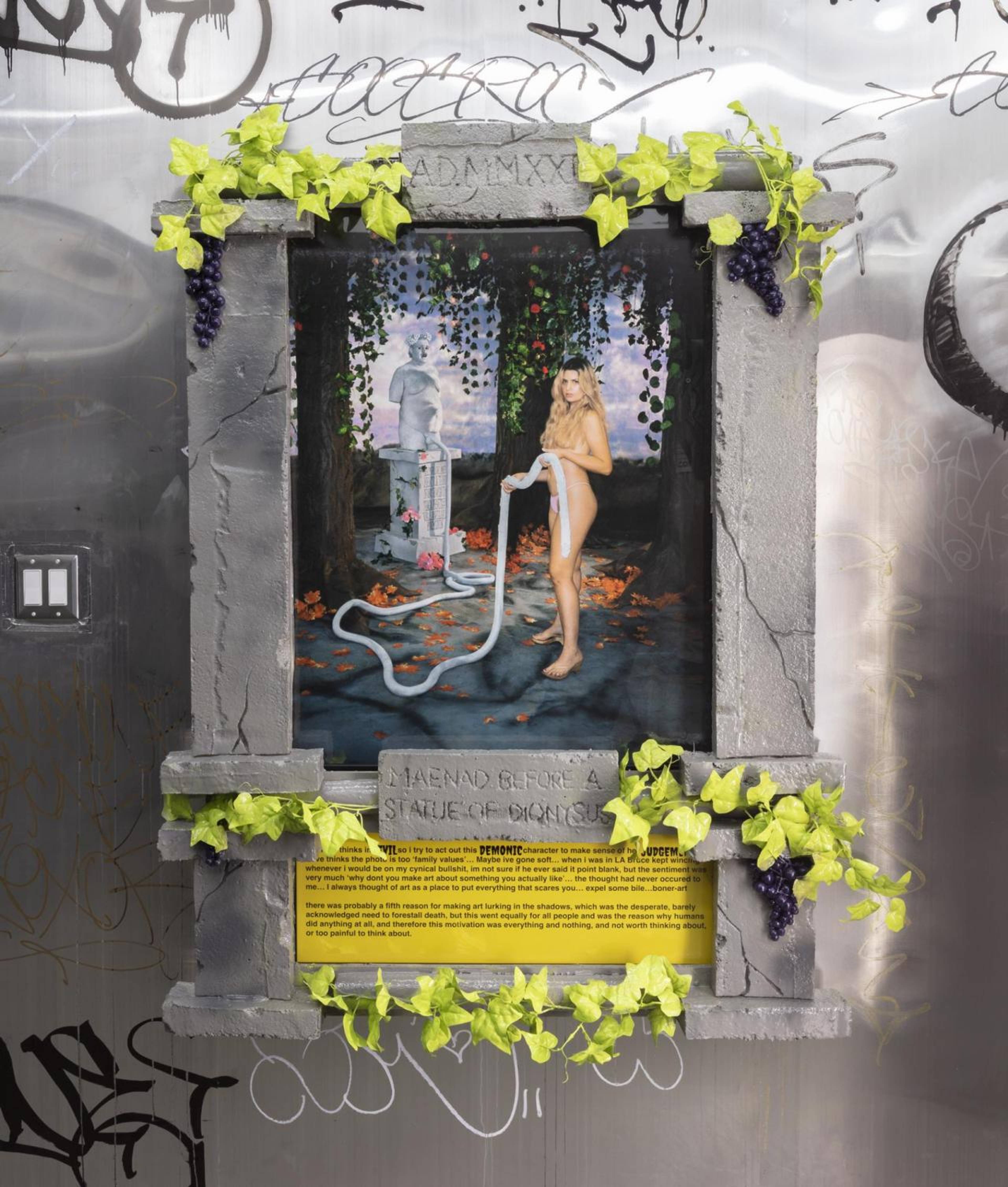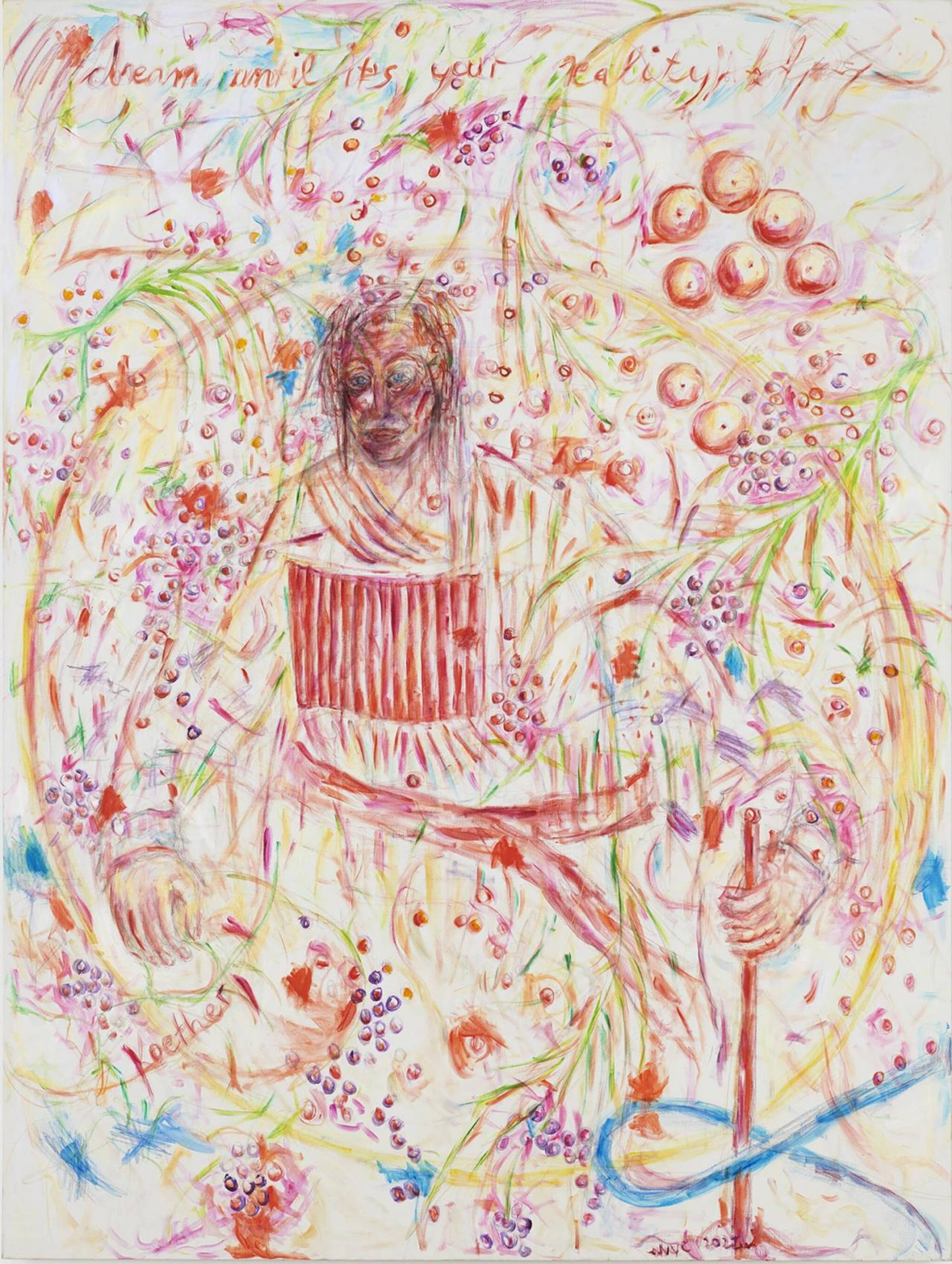“Dear Viewer,
You have no future. Everything that was envisioned, projected, speculated, sold, claimed, sent into space, came crashing down with war. Everything in this gallery is real, except for you.”
– “Stolen Sun: Artists from Ukraine,” organized by Lika Volk, Miguel Abreu Gallery
“Plagued by insomnia and grappling with processing the toll the past few years have taken, Curtiss often felt like a sleepwalker herself while creating this body of work–day and night, light and darkness running into each other in a blurry timeless vacuum.”
– Julie Curtiss, “Somnambules,” Anton Kern Gallery
“Employing what the artist has called ‘hypostatic abstraction and intense social realism,’ the exhibition conveys themes of separation, suffering, infancy, and fragility. Wilkes grew up in Northern Ireland. Her new work contends with the lingering after effects of her childhood, meditating on brutality, loss, and continuity.”
– Cathy Wilkes, Ortuzar Projects
“In her work McClodden has engaged with ‘masking’ and its many meanings and guises, as well as ‘unmasking,’ in which, as an autistic adult, she attempts to unlearn an assimilationist tendency to suppress one’s true self in order to appear neurotypical. This relates closely to ‘concealing,’ a purposeful act of obstruction that, along with ‘carrying,’ suggests associations with firearms regulation in the United States. ‘Carrying’ also touches on deeper psychological aspects regarding trauma and burden that are threaded through the works.”
– Tiona Nekkia McClodden, “MASK / CONCEAL / CARRY,” 52 Walker
Emily Mae Smith, Habitat, 2022. Courtesy: the artist and Petzel Gallery
“Through this surrogate, Smith refuses the masculinist pretension of using the female body as a catalyst for formal experimentation while preserving its potential for mutability. Indeed, beyond the variability of its costuming – eyeless rods sport full skirts or pantaloons fashioned out of gathered bristles – brooms behave differently, most conspicuously laboring or refusing instrumentalization.”
– Emily Mae Smith “Heretic Lace,” Petzel Gallery
“The surfaces of these works are built over tracings of enlarged pages of heavily redacted government documents, including Special Counsel Robert Mueller’s report on Russian interference in the 2016 US Presidential election and FBI records pertaining to the Patriot Act. Holzer meticulously covered the redactions and blank space with colorful blocks of oil paint before adding layers of luminous gold, platinum and other metal leaf.”
– Jenny Holzer, “DEMENTED WORDS,” Hauser & Wirth
“As Thomas continues his internal exploration of what it means to be an ‘American,’ he has begun to view nation states as creative collaborations, and artists as the greatest problem solvers.”
– Hank Willis Thomas, “Everything We See Hides Another Thing,” Jack Shainman Gallery
Sable Elyse Smith, Coloring Book 103, 2022
“For over a decade, Smith has built a practice from tracing the threads of violence and power embedded within systems of belief, infrastructure, language, even intimacy. Spanning a broad range of media, Smith’s work samples and splices moments extracted from visual culture and the built environment, using strategies of repetition interwoven with gestures of poetic intervention to reveal implicit constructs of social control.”
– Sable Elyse Smith, “Tithe,” JTT
“Spanning the early months of 2022 through the final weeks of summer, this body of work reflects the artist’s waxing and waning optimism across a tumultuous and transformative year. Much like the days whose light increases and decreases on either side of the seasons, the year began with growing potential for communal healing and social upheaval, yet it seems to be ending on a more tentative note.”
– Christina Quarles, “In 24 Days tha Sun’ll Set at 7pm,” Hauser & Wirth
“Its strange that its been 3 years since i was last here. Back then I think we all had a sense of impending doom. maybe in a fucked up way it was a cathartic release when something bad finally happened. im glad that my attempt to cynically expose and ridicule the social/economic fabric of the art industry was a total failure. i guess now i can appreciate how fleeting all of this is …”
– “Sex is [Censored] Part 3: Le Pissoir du La Perle,” presented by Zac Segbedzi, Jenny’s
“Here, Koether addresses unhinged-ness as a condition of our time – the emotionally, mentally and literally unhinged people of New York and everywhere.”
– Jutta Koether, “eVEryTHinG WilL ChaNGe,” Reena Spaulings Fine Art
Eric Fischl, Please Wait, Sir, 2022. Courtesy: the artist and Skarstedt
“In Please Wait, Sir, a menacing adult in a plague doctor mask that suggests associations with our present pandemic stalks an oblivious young girl eating ice cream, her brother trying in vain to stop him while a single tear falls down the mask, hinting at preemptive remorse for what is to come. Others seem to feel nothing at all, perhaps so overwhelmed by recent events they have become inert …”
– Eric Fischl, “Towards the End of an Astonishing Beauty: An Elegy to Sag Harbor, and Thus America,” Skarstedt
UPTOWN
Eric Fischl
“Towards the End of an Astonishing Beauty: An Elegy to Sag Harbor, and Thus America”
Skarstedt Gallery
14 Sep – 29 Oct 2022
Let’s begin. It’s 9:50 AM at the top of Manhattan. Eric Fischl has painted a Sag Harbor Halloween, a series of scenes from the yearly “Ragamuffin Parade” through the beachside Hamptons village he calls home. Halloween (2022) shows a lady dressed up as a magical being having her picture taken in a Hamptons gallery, in front of a George Condo and behind a Roy Lichtenstein sculpture. The spaces of gallery art, pagan carnival, and weird twisted Americana are collapsing into one another.
Issy Wood, Roger Sterling with future ex-wife, 2022. Courtesy: the artist and Michael Werner
Issy Wood
“Time Sensitive”
Michael Werner
9 Sep – 12 Nov 2022
This is a world of good taste and lovely well-rendered surfaces but inside it is rotten, it is abject. There is a hole in the back of your neck, holes in your mouth, your life looks great on the surface but inside you are rotten.
There are painterly flourishes here but used sparingly: a glow of Rubenesque light on a cow’s udder on velvet. A scrape of black on the trim of the waistcoat of Roger Sterling with future ex-wife (2022) that can only be seen in person and does not show up in the photograph of the work. If I could have any of the paintings I’ve seen over these past couple days visiting dozens of big September gallery shows across Manhattan, I’d have this one: because I like the subject matter and the flourish of black paint on the trim, and because it’s worth a hell of a lot of money. Issy Wood is part of the new wave of Millennial figurative painting stars. She is the one, my guy at the auction house says, that everybody wants.
The art world today is what advertising used to be. The playboys I hear of today, the new Don Drapers, are not advertising men, not artists or collectors, but dealers.
The art world today is what advertising used to be. 19th Street is Madison Avenue. The playboys I hear of today, the new Don Drapers, Roger Sterlings, creepy Pete Campbells, are not advertising men, not artists or collectors, but dealers. It’s the dealers that date socialites, that marry celebrities, that party with the biggest stars in the world, the dealers that steal their artists’ girlfriends and drive those artists into the arms of other dealers. But rather than selling a dream to the masses, they are selling luxury images, paintings, to the very, very wealthy.
Everybody appears to be having a hard time on paper. The exhibition texts I’ve read – some of which are good and most of which are not – from the shows I’ve been to see often paint a picture of a world that’s collapsing and artists that are suffering. The artworks themselves are mostly light and pleasant, very tasteful above Houston, and seem, on their surfaces, generally devoid of politics or social commentary, but in the accompanying texts everyone is suffering. A disconnect has opened up between the way we have learnt to talk about art and what is being made, with International Art English transmuted into cursory notes of despair. Like Mathieu Malouf said a couple years ago, of the New York art scene, “Everyone wants to be treated like someone that’s extremely depressed.” There does seem to be a lack of joie de vivre going around. A feeling of perverse accountability hangs over everything, or at least that’s how art is spoken about today: as a sort of palliative for suffering, for a doomed dying world. It can feel, reading exhibition texts, that what’s really being sold is trauma, vulnerability, and structural oppression. As Mad Men once told us, “This product is special and will improve your life, let’s teach the world to sing,” the dealers now promise, “This very expensive painting will refract our suffering, the pain of the world, and channel it into something beautiful, yes, beautiful.” It’s a strange sort of luxury good.
There are so many galleries in this city it’s completely out of control, so many galleries opening up, so many opening more spaces, so many viewing rooms I don’t ever even get to see, hidden behind those closed doors, and all of these galleries are having so many shows, a new show every month, and working with so many artists; there are so many artists making so many paintings, so many of which are selling it defies belief. I can’t believe there are so many wealthy collectors buying so many paintings from the hundreds of galleries and thousands of shows in the city each year but there are. It says a lot about booming inequality and how much money the wealthy have now, with nothing much to spend it on, and also how images have swallowed the world, how the trade in images has expanded far beyond the wildest dreams of a 1960s ad man.
Andro Wekua, Sea Cut, 2020–22. Courtesy: the artist and Gladstone Gallery
Andro Wekua
“Sea Cut”
Gladstone 64
14 Sep – 22 Oct 2022
A frisson in my heart at the patch of sunset orange rung with green. Andro Wekua moves between figuration and abstraction, which is the dominant trend this season. His paintings are modernist but dreamlike and romantic. There’s something so specifically Georgian about his paintings says my friend Damon Sfetsios, upon finding out he’s Georgian. Tbilisi is full of this sort of painting he says. We both like it.
Fischl, with his carnivalesque scenes, Wood with her domestic uncanny, and Wekua with his formalist romanticism are leaving the everyday world behind. The world is whatever you make of it, the world is its own representations. “What does ‘from life’ even mean in this day and age?” Wood has asked. It’s all coming apart. A drowsy, dreamy influence seems to hang over Uptown and down across the city.
Gabriel Orozco, "Spacetime", 2021–. Courtesy: the artist and Marian Goodman Gallery
Gabriel Orozco
“Spacetime”
Room 305, Marian Goodman Gallery
Through 2023
This show feels dreamlike in another way. It’s in an off space in a hallway that would normally not be accessible from the gallery, behind a door that says “SPACETIME.” Visiting feels like wandering into a hidden space between the offices and the galleries, a seventh-and-a-half floor space, and stepping out of busy calendar time into an off-schedule exhibition apart from the never-ending cascade of shows. Gabriel Orozco doesn’t have a studio and has stored his inventory in Marian Goodman’s warehouses for almost thirty years now. Over the last one however a slowly rotating selection from that inventory has been installed in Room 305, in the compact office spaces recently vacated by another gallery that had been dealing Dada and Surrealist art from there for nineteen years. “Spacetime” is a working archive open Monday to Friday, 10:00 am to 6:00 pm. There are three rooms, plus a “spaceship room” and some offices, all of which are small and full of works; showing an archive like this makes a lot of sense during this backward-facing moment in contemporary art, when the past is continuously being excavated or remade and linear time and geographical space have broken down.
In the spaceship room, on one of the shelves, there’s an unfolded Odeon napkin stained with a coffee ring.
“My coffee stain is poetic art,” says Damon, who lives in a cultlike bohemian loft in Brooklyn, “I miss this kind of thing.” He says in a place like this the napkin becomes enchanting. Maybe the problem is not the art that we show but the spaces in which we show it, and it’s the context that needs changing. There are way too many galleries and they all look the same and they all show more or less the same thing, and who could not be exhausted by this, who could not be bored. The art world has, for the most part, turned against modernism and its ideals, certainly against the modernist idea of a progression of movements, and yet the empty white modern gallery form remains very much intact. It’s time to leave the gallery and the museum, it’s time to go home, or someplace else, or disappear into spacetime.
Justin Caguiat, Daisyworld, 2022. Courtesy: the artist and Greene Naftali
CHELSEA
Justin Caguiat
“Carnival”
Greene Naftali
15 Sep – 22 Oct 2022
The painting Hysteresis Loop (2022) is made with thermochromic pigments on heated metal: its waxy matte blue and purple tones on warm radiant heat substrate are in places unbearably lush. The others are made with oil and gouache on linen.
Justin Caguiat is another painting star of the moment and very much in demand. This show is not what I want from art because it’s so decorative, craft-based, and tasteful, “excessively tasteful,” another friend suggests. But it’s also very seductive, and perhaps so because how obscenely, excessively tasteful it is, and how much romantic kitsch decadence is on show. This is the path that painting is going down: abstraction mixed with figuration in a dreamlike carnivalesque manner. In these paintings though the figures are hard to make out. They hide in all the pretty hazy layered colors soaked into the cloth and only in places do their ecstatic expressions or languorous, transcending limbs or appear like silhouettes of Cheshire Cats, fading in and out of the psychedelia. The hoped-for emotional effects of these compositions are shown as rapt faces and humming bodies rising out of the floating world, assembling themselves from the patterns; as if we are the figures trapped in the world of images, in the matrix of symbols and shadows, taking the pastel lavender, rose, peony, celadon, bergamot, tea dust, floating cloud pills. Caguiat’s paintings both resemble and follow a similar secessionist impulse to Klimt, I feel: to abandon the real world and naturalistic effects in favor of a symbolist musical reverie of emotions and pleasure.
Christina Quarles, Same Shit, Diff'rent Day, 2022. Courtesy: the artist and Hauser & Wirth
Christina Quarles
“In 24 Days tha Sun’ll Set at 7pm”
Hauser & Wirth
Through October 29
I’m also reminded of Klimt by Christina Quarles’s decorative flattened patterns and focus on female bodies as erotic objects. She’s another star of the new wave of figurative painters, the greatest of all since her Night Fell Upon Us Up On Us (2019) went for $4,527,000 at Sotheby’s this spring. Much of this wave can be dismissed as derivative but Quarles cannot, because her work is so strange and technically brilliant. She paints emaciated, elongated figures twisted into orgiastic scenes, hovering on the boundary of perversity but never crossing over. Different styles and techniques are combined on every canvas. I can usually get lost in the details of her forms, but her gestalt compositions never have much of an emotional or aesthetic effect; the whole always feels less than its parts. I find myself wishing some of these rich details would grow into entire paintings of their own. Instead, every mark is a virtuoso painterly flourish and every painting a collection of flourishes without a punctum.
“All we’re doing,” Damon complains, “is appreciating quality of make. But what does it make us feel?”
I don’t feel a thing. The compositions don’t cohere and apparently they’re not supposed to. These bodies are dancing, embracing, making love or fighting, wrestling – the person they are wrestling however is themself. I read in the handout that these paintings are “visualizing what it feels like to live within a body while grappling with an excess of identities.” That, “vibrant magentas, blues, greens, and yellows serve not as a means of describing reality but as a way of actively resisting the viewer’s instinct to assign binary classifications like male or female, white or black, abstract or representational, to the figures.” So a reason is given for the clashing of registers: this is how figurative painting looks now that we have an excess of identity, now all the binaries are collapsing and there is no such thing as a simple figure. Abstraction versus representation is just another binary to tear apart (again). The new symbolist painting is not an advocation of absolute truths but rather an expression of the total indeterminacy of everything today.
this curious moment in history in which we don’t seem to know what it is we desire apart from ourselves
These paintings are, the text implies, psychological self-portraits: “A visual analogy for the push and pull between our public and private selves and inner and outer voices, the work calls attention to society’s constructs around identity, and the potential for excess and expanse where limitations were once prescribed.” At this moment when the art world is obsessed with identity and when so many dealers are attempting to capitalize on the identities of their artists, Quarles’s project of expanding and exploding identity and exploring the limits of what a person might be is an appealing one. However, all her paintings with their variety of techniques and forms just end up looking the same to me, and the infinite unknowability of our fractured identities is made to appear quite repetitive and flat, and lifeless, reflecting this curious moment in history in which we don’t seem to know what it is we desire apart from ourselves.
Downstairs at Hauser & Wirth, we also bump into a friend who recommends we go see another show a few doors down. He says an unusual phenomenological effect has been created there by accident and he goes there on his lunch break to unwind.
Zac Segbedzi, Maenad Before a Statue of Dionysus, 2021–22. Courtesy: the artist and Jenny's. Photo: Joerg Lohse
Sturtevant
Matthew Marks
10 Sep – 22 Oct 2022
In the back space of the Sturtevant show, past her remakes of Duchamp’s portrait of Man Ray, and Warhol’s Flowers and Johns’s Numbers, the techno soundtrack of her film Simulacra (2010) and the gallery architecture – the recessed skylights in the ceiling – combine to create an unplanned phase cancellation effect. As you walk through the gallery the music seems to disappear inside your brain in a dizzying, unbalancing way. You can feel it come and go in front of Sturtevant’s Gober Partially Buried Sinks (1997), which emerge from the artificial grass like two graves. Art can pull you out of reality and give you an experience nothing else will without even meaning to.
Mary Heilmann
“Daydream”
303 Gallery
17 Sep – 29 Oct 2022
A procession of glum-seeming Chinese art students troops out of the Sol LeWitt exhibition at Paula Cooper in knee-high boots. We see them again in 303 but now they look excited as they leave the daydream of bright Mary Heilmann monochromes, following a classmate kicking gently a lanternfly across a concrete floor.
“You have to kill it!” Damon says, and I say, “No you mustn’t!”
The student’s friend says, “We’re bringing it out of the gallery and then she’s going to kill it.”
It’s okay to kill it here, we say, it’s fine, the gallery won’t mind, and she does.
Lanternflies glow grey-violet and crimson. They have a color all of their own. The plague of the lanternflies in New York has felt like living in a city invaded by a color, a certain rosy crimson that descends one late summer, a wonderful color that everyone is told to kill, and they do, they stomp it out on the sidewalks and in the squares. This is a symbolist happening too, a very magical realist thing to manifest in a city.
Jutta Koether, Dream until it's your Reality, 2022. Courtesy: the artist and Reena Spaulings Fine Art
DOWNTOWN
“Sex is [Censored] Part 3: Le Pissoir du La Perle”
Presented by Zac Segbedzi
Jenny’s
30 Sep – 29 Oct 2022
The concept here is a recreation of the stainless steel bathroom at La Perle in the Marais, Paris, a famous fashion bar and the site of John Galliano’s downfall. Jenny’s pissoir is lined with found graffiti-strewn steel walls on which are hung fashionable works like Pierre et Gilles’ ornate portrait of Balmain’s dreamboat creative director Olivier Rousteing, Amelie von Wulffen’s painting of a rainbow-faced woman, and Jeremy Glogan’s London skyline with a face, The Gherkin (2010). Cosima von Bonin’s plush little Saint Bernard dog sculpture sits on the bathroom floor. The show was put together by Zac Segbedzi, whose own wallwork Maenad Before a Statue of Dionysus (2021–22) has a caption about what drives us to create and has done so since before antiquity: “a fifth reason for making art lurking in the shadows, which was the desperate, barely acknowledged need to forestall death, but this went equally for all people and was the reason humans did anything at all, and therefore this motivation was everything and nothing, and not worth thinking about, or too painful to think about.”
We are all going to die and should make the most of our time, and needn’t be too glum and too earnest about everything. At the heart of the exhibition is Mathieu Malouf’s “Air”/”stream” (for Virgil) (2022), a sculpture of a bathroom stall and a tribute to Virgil Abloh of sorts: the urinal part is marked “STREAM” in Virgil’s postmodern style, and the work feels like a combination of his aesthetic and his great inspiration, Duchamp. There’s a lot of doom going around and those like Mathieu and Zac and Jenny who bring a certain levity, of any sort, to proceedings help lift the miserable gloam in a good way I feel. La Perle is a wonderful bar and this is an enjoyable show; the pissoir, like “Spacetime,” can take you out of New York and into a whole other realm. There’s also a metaphysical garden nearby.
Jutta Koether
“eVEryTHinG WilL ChaNGe”
Reena Spaulings Fine Art
8 Sep – 16 Oct 2022
Jutta Koether’s painting Dream until it’s your Reality (2022) remakes a late Rembrandt self-portrait from 1658 that hangs in the Frick Madison, in the brutalist, near-windowless Breuer Building that was completed in 1966 on Madison Avenue and intended as a challenge to the ad men in their glass towers. Art has since taken over the city.
Rembrandt chose to paint himself at a terrible time in his life, close to financial ruin, standing defiant with a red sash round his waist and cane in his hand. In Koether’s version he’s surrounded by red and purple fruit, “unhinged grapes” representing chaos and change in her painterly symbolist language. He’s in the garden; not a real garden, not destitute, broken old melting-down Rembrandt’s garden but, we are told, “the opening-up of a strange, semi-wild place to articulate and curate all kinds of growth and mutation. The garden is a zone of work where pasts and futures connect and combine in sudden, unforeseen ways. Going always further down the path of painting, but never in a straight or pre-programmed line: the garden is an explosion within its bounds.” Everything can change here. He has a blood-red face. He’s contained inside a massive unhinged grape, a Bosch-like bubble similar to the one two lovers float by in across the central panel of the Garden of Earthly Delights. Rembrandt is reimagined here as a shaman, a magician in the garden transforming reality. Above him is painted the slogan, “Dream until it’s your reality.”
That phrase used to be written all over Downtown, on the sidewalks and walls in colored chalk. “Dream until it’s your reality.” It encourages a particularly American idea of manifestation –aspirational thoughts can transform the real world – that I enjoyed seeing all the time and tried to take onboard, or rather, to live my life as though it were a dream and did not matter so much. But one afternoon I saw this guy knelt over on the sidewalk in SoHo scribbling “Dream until it’s your reality” on the sidewalk in chalk and he was a downbeat-looking guy, very ordinary, not a figure from dreams, and since then the message lost its potency for me; and now I don’t see it anymore anyway, it’s stopped appearing, except in this exhibition. Most of the new paintings in the city this fall have the opposite message: Dream until it’s not your reality. This dreamy, surreal, lanternfly-like wave of decorative abstract figurative painting promises to help you escape, to take you somewhere else, and leave the real world far behind.
___


